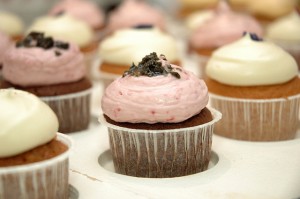Nothing says neighborhood change and gentrification like a cupcake shop. But what if such a shop has bulletproof glass inside? The Washington City Paper reports that the first cupcake shop east of the Anacostia River, Olivia’s Cupcakes, has a “thick sheet” of bullet-resistant glass behind the counter:
“It broke my heart to do that, but it’s a deterrent,” says proprietor Cindy Bullock, who runs the cupcake shop alongside her husband, Bob Bullock, and their daughters, Kristina, 20, and Alexis, 18.
“Several people asked (about the glass) and said, ‘It’s a beautiful shop, its unfortunate that you have it up,’ but we had to have it,” Bullock says.
“I have owned several business in this area and we have been robbed several times,” she explains. “We wanted to make [the shop] elegant and beautiful, but because of the teenagers and having my children here we wanted to protect them.”
D.C.’s bullet resistant glass initially appeared in stores in the wake of the 1968 riots, and became much more widespread at the height of the crack epidemic. Like the Bullocks, many store owners have installed glass after bad experiences.
In gentrifying neighborhoods, the glass barricade coming down is a turning point. It’s also sometimes necessary to appeal to a wealthier clientele. Take Logan Circle, where most liquor and convenience stores had the glass for decades. Then Whole Foods opened on P Street, NW in 2000. Property values rose, and Amare Lucas, owner of Best-In Liquors on P and 15th streets NW decided to take down his glass. The more inviting atmosphere, along with new stock he brought in, attracted more customers, new and longtime residents alike. “Some [customers] told me they had been in the neighborhood for 15 years, kind of passing the store by because of the glass,” Lucas told Washington City Paper‘s Dave Jamieson in 2005. “They’re in my store now. It really gives you a satisfaction.”



